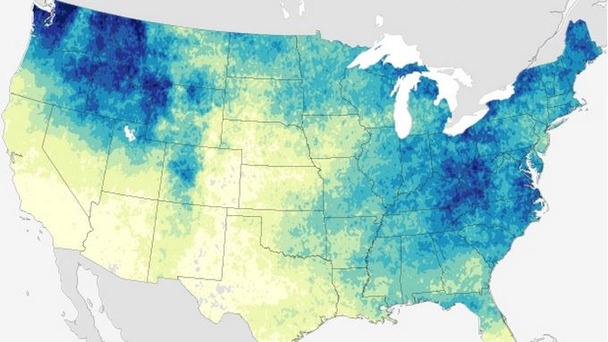
NOAAClick to embiggen.
Squelch, squelch, squelch — that could be the sound of future America, if predictions about how climate change will ramp up “extreme rainfall” prove accurate.
Say the world’s nations do little to reduce the amount of greenhouse gases pouring into the atmosphere. By the years 2041 to 2070, the warmer climate could bring torrential downpours to vast parts of the United States, as shown in this model from NOAA. Dark-blue splashes depict areas that might see as many as two or more days a year of extreme rain, defined as “rainfall totals in excess of the historic 98th percentile.” (This is against a 1971 to 2000 baseline.) Cities that should maybe consider wooing the umbrella-manufacturing industry include Seattle, Wash.; Portland, Ore.; Boise, Idaho; Richmond, Va.; and much of the Northeast.
The climate folks at NOAA add:
Climate models project increasing days of extreme rainfall in the Northwest, Midwest, and parts of the Northeast, including some populated coastal areas that are already challenged by inundation and sea level rise. Several major watersheds are predicted to have more days of extreme rainfall by the middle of the century, including the Pacific Northwest, the Ohio River Basin, the Great Lakes, and parts of the Great River and Missouri River Basin. Meanwhile, the Southwest and some other areas frequented by drought are expected to see little difference in the number of extreme rainfall days.
The model is based on the findings of a 2009 national climate assessment, which include the moist bulletin that over the past 50 years precipitation already increased by 5 percent. The bulk of rain falling during especially heavy storms, meanwhile, is thought to have ratcheted up by 20 percent on average in the last century. Scientists generally believe the warming climate will make the northern parts of the country wetter, while the southern and western zones will progressively dry out.
Before anybody interjects, “Can you really sell that while also selling more intense and frequent drought?” — as one Twitter guy just did — NOAA has provided an answer. The agency tweets: “Climate models show that in a warmer world, precip tends to be concentrated into heavier events w/ longer dry periods in btwn.”
 This story was produced by The Atlantic Cities as part of the Climate Desk collaboration.
This story was produced by The Atlantic Cities as part of the Climate Desk collaboration.



